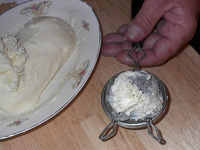Easter Butter Lamb
Updated:
This recipe is all about the technique of putting it together. I can't emphasize too much that the butter MUST be the proper temperature to make the fur. Too soft and it will come out like butter (smooth, shiny, and unlike any fur that I've ever seen), too cold, and you won't be able to press it through the strainer.
Because this is a special day and we usually purchase a better grade of butter for this dish. Normal Grade "AA" butter has 80% butterfat content, it doesn't matter which brand, they're all exactly the same. We usually purchase a richer European style butter that is about 90% butterfat content. It tastes different, being a little richer. By no means try to use a spread because it can't be done.
This is not only a decoration for the table, but it is meant to be eaten. You'll probably have to be the first to dig into it, and you should always begin at the part that would go over the fence last. This will preserve the head for most of the meal.
All in all I hope that this will bring back some memories for some of you, and maybe start new traditions for others.
- 1 Pound, Salted Butter, European Butter
- 4 Whole, Cloves

1. Try to get one solid block of butter. If you'll look closely at this one, I had 2 half pounders, and had to let them get real soft so I could put it together. I then trimmed a little off the top of where the body would be and added that piece to the end to make it a little longer. I've also started the process directly on the plate I'm going to serve on. That's because it would be impossible to slide off the finished product to a different plate.

2. This shows how much butter was taken off, as well as how the base (sheared) lamb looks

3. A better picture of the lamb prior to putting any fur on him. One thing about the neck. Over the years there have been many funny disagreements about my Mother's lamb telling her that it looked like a collie instead of a lamb. I finally figured it out, by accident, that if you make the neck too tall, it will look more like a dog than a lamb. Be sure to make a very short neck, so it'll look like a lamb.

4. To make the fur, work with the butter you've shaved off the block. Be careful of the temperature. It should be quite cold and a little hard. While you're working with it, you will probably have to put it in the freezer for a couple of minutes every once in a while. If this butter gets too warm, it will come through the mesh and not be separated. For 2005, I probably placed it back in the freezer 5 - 6 times, for the length of time it took me to take the fur off the strainer.

5. Pushing the butter through the strainer.

6. A picture of when the butter was too soft. If you look closely, you can see where the butter is a little shiny and smooth where it was too soft (warm).

7. The first of the fur around the neck. This illustrates how thick the fur should be.

8. Taking the fur off the strainer with a thin, pointed knife.

9. On the larger areas you can slide the fur off with your finger. However, if you're working around the neck of the base, you might want to slide it off with another knife.
10. Last, but not least, place the cloves for the eyes, nose, and one rear hoof.
10. Last, but not least, place the cloves for the eyes, nose, and one rear hoof.


